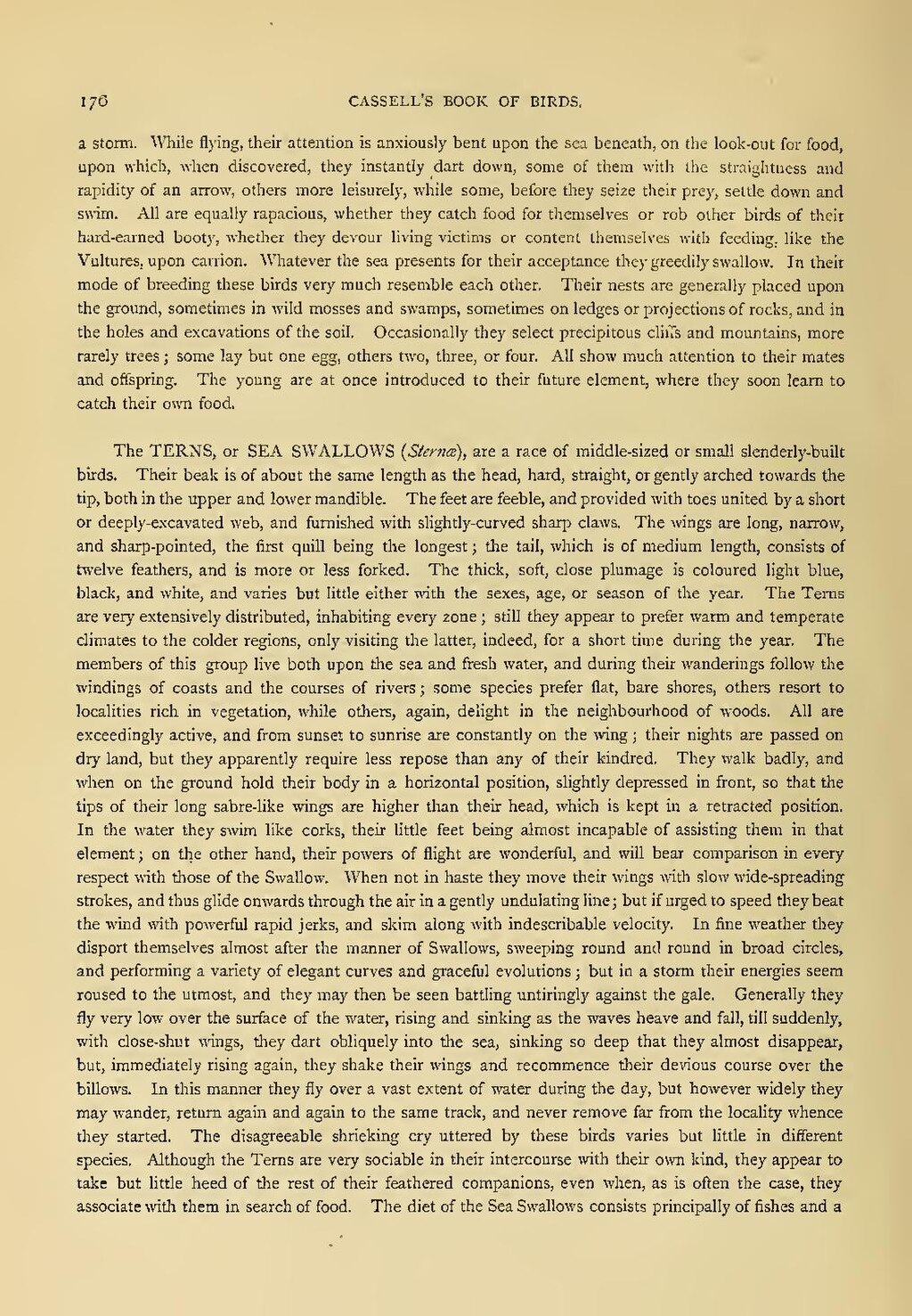a storm. While flying, their attention is anxiously bent upon the sea beneath, on the look-out for food, upon which, when discovered, they instantly dart down, some of them with the straightness and rapidity of an arrow, others more leisurely, while some, before they seize their prey, settle down and swim. All are equally rapacious, whether they catch food for themselves or rob other birds of their hard-earned booty, whether they devour living victims or content themselves with feeding, like the Vultures, upon carrion. Whatever the sea presents for their acceptance they greedily swallow. In their mode of breeding these birds very much resemble each other. Their nests are generally placed upon the ground, sometimes in wild mosses and swamps, sometimes on ledges or projections of rocks, and in the holes and excavations of the soil. Occasionally they select precipitous cliffs and mountains, more rarely trees; some lay but one egg, others two, three, or four. All show much attention to their mates and offspring. The young are at once introduced to their future element, where they soon learn to catch their own food.
The TERNS, or SEA SWALLOWS (Sternæ), are a race of middle-sized or small slenderly-built birds. Their beak is of about the same length as the head, hard, straight, or gently arched towards the tip, both in the upper and lower mandible. The feet are feeble, and provided with toes united by a short or deeply-excavated web, and furnished with slightly-curved sharp claws. The wings are long, narrow, and sharp-pointed, the first quill being the longest; the tail, which is of medium length, consists of twelve feathers, and is more or less forked. The thick, soft, close plumage is coloured light blue, black, and white, and varies but little either with the sexes, age, or season of the year. The Terns are very extensively distributed, inhabiting every zone; still they appear to prefer warm and temperate climates to the colder regions, only visiting the latter, indeed, for a short time during the year. The members of this group live both upon the sea and fresh water, and during their wanderings follow the windings of coasts and the courses of rivers; some species prefer flat, bare shores, others resort to localities rich in vegetation, while others, again, delight in the neighbourhood of woods. All are exceedingly active, and from sunset to sunrise are constantly on the wing; their nights are passed on dry land, but they apparently require less repose than any of their kindred. They walk badly, and when on the ground hold their body in a horizontal position, slightly depressed in front, so that the tips of their long sabre-like wings are higher than their head, which is kept in a retracted position. In the water they swim like corks, their little feet being almost incapable of assisting them in that element; on the other hand, their powers of flight are wonderful, and will bear comparison in every respect with those of the Swallow. When not in haste they move their wings with slow wide-spreading strokes, and thus glide onwards through the air in a gently undulating line; but if urged to speed they beat the wind with powerful rapid jerks, and skim along with indescribable velocity. In fine weather they disport themselves almost after the manner of Swallows, sweeping round and round in broad circles, and performing a variety of elegant curves and graceful evolutions; but in a storm their energies seem roused to the utmost, and they may then be seen battling untiringly against the gale. Generally they fly very low over the surface of the water, rising and sinking as the waves heave and fall, till suddenly, with close-shut wings, they dart obliquely into the sea, sinking so deep that they almost disappear, but, immediately rising again, they shake their wings and recommence their devious course over the billows. In this manner they fly over a vast extent of water during the day, but however widely they may wander, return again and again to the same track, and never remove far from the locality whence they started. The disagreeable shrieking cry uttered by these birds varies but little in different species. Although the Terns are very sociable in their intercourse with their own kind, they appear to take but little heed of the rest of their feathered companions, even when, as is often the case, they associate with them in search of food. The diet of the Sea Swallows consists principally of fishes and a
